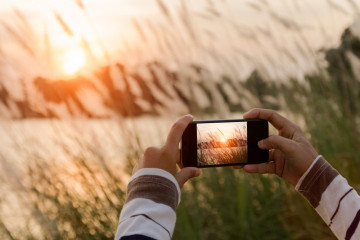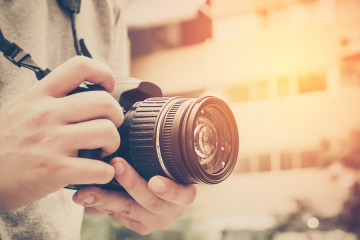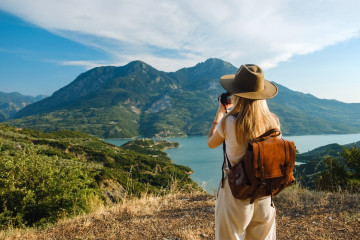Is a Smartphone Camera Good Enough?
Photography, as we know it, is in a very interesting place right now. The technological advances that have been made by smartphone makers have many people wondering if their smartphone is as good as a dedicated camera like a DSLR. Serious photographers know that it’s not. However, for an increasing number of people, the quality that you get from a smartphone camera is good enough. Herein lies the challenge for the future of photography. Is good enough the new normal?
The Rise of Smartphone Photography
Every time that Google, Apple, or Samsung releases a new flagship smartphone, they go to great pains to highlight the improvements that have been made to the camera. They dazzle us with the latest tech specs, show us their new capture modes, and wow us with sample images that look like they couldn’t possibly come from a smartphone. Why? Because the quality of the camera in a smartphone is one of the biggest, if not the biggest, factor that drives consumers to upgrade their phones.
All the top smartphone manufacturers want you to know that they have a camera that is worthy of your money. Apple encourages iPhone users to share their best photos on Instagram with the hashtag #ShotOniPhone and will often share the best of these images in TV ads for the iPhone. Google recently partnered with John Legend to film a music video that was shot entirely on the Google Pixel 2, and Samsung struck a deal with the International Olympics Committee to give every athlete the chance to record and share their best memories on a Galaxy Note 8 at the 2018 Olympics. Smartphone cameras are good for business.
Can a Smartphone Replace a DSLR Camera?
So, is it marketing hype or are the best smartphone cameras actually capable of being a good replacement for a DSLR from Nikon and Canon, or a mirrorless camera from Sony or Olympus? From the perspective of a professional photographer, with high-end gear, the answer is clearly no. You will not see professional photographers using smartphones as their main camera at weddings and sporting events. But what about amateur photographers? What about parents, teens, and everyone else? Could an average person with little or no formal training really take better pictures with a DSLR than with a modern smartphone? That’s a little less clear.
A DSLR Is Better Than a Smartphone
Dedicated cameras have a lot of versatility and will likely always be able to do things that a smartphone can’t. For instance, you can’t attach a 200mm telephoto lens to your smartphone, and even if you could, you would probably look kind of ridiculous doing it.
The resolution of photos taken on DSLR and mirrorless cameras is also much greater than the resolution of smartphone cameras thanks to their larger sensors that number up to 40 megapixels or more. What about the megapixel myth, I hear you cry? It’s true. More megapixels does not mean a better photo, but that brings me to my next point. The sensors in dedicated cameras are much larger than smartphone cameras and that means they can let in a lot more light and produce better photos, with more dynamic range, in low-light scenarios.
A DSLR will also typically give you more creative control when it comes to exposure. You have absolute control over your shutter speed, aperture, and ISO settings so that you can create those blurred waterfalls and beautiful bokeh backgrounds. Smartphones can simulate a lot of these scenarios, but they are only as good as the software that they ship with.
Finally, DLSR cameras have great batteries that should easily last you a day, or more, of shooting, and if you do happen to run out, you can quickly swap in a spare battery and continue shooting like nothing ever happened.
A Smartphone Is Better Than a DSLR
Case closed? Not yet. Your smartphone is not going to give you the range of a 200mm telephoto lens, but what it lacks in range, it makes up for in spontaneity. People carry their smartphones everywhere they go. That’s less true with a dedicated digital camera. Just think about how many photos you would miss if you didn’t have your smartphone with you.
A DLSR with a 200mm lens on it is going to be great in many scenarios, but it’s also going to be heavy, a little cumbersome, and it will add extra weight to your neck and shoulders. Done shooting with your smartphone? Stick it in your pocket and move on.
Hi-res smartphone sensors are not going to be commonplace in smartphones for a while, but most people don’t need that much resolution unless they are printing poster-sized pictures. If you’re printing photos at 6×4, 5×7, or even 8×10, your photos will look great when taken in decent light. If you prefer to view your photos on a laptop to TV, you are equally well served.
The batteries in today’s smartphones tend not to last for more than a day, but that works out fine because we all charge our phones on a regular basis, and if you do start to run out, battery packs can be used to top you up when you need it. And, at the end of the day when you are finished shooting, you can edit your pictures in Lightroom, post the best ones on Instagram, and backup your photos to the cloud without ever removing a memory card or connecting your phone to a computer. Try doing that on your DSLR.
The Best Smartphone for Photography?
Smartphone photography definitely has its pros and cons, but for many people, the cons are not as big as they used to be. With that in mind, you may be wondering which smartphone is best for photography. A good place to start is the mobile camera reviews from DxOMark. Since 2008, DxOMark has been scientifically measuring the image quality of smartphones, lenses, and cameras. On their website, you can see the top-performing cameras from all manufacturers and compare one against the other with raw specs and sample images. They use state-of-the-art equipment and give each smartphone a quality score that you can use to compare it to its rivals.
Conclusion
In the end, it all comes back to the notion of good enough. Is a smartphone good enough to meet your photographic needs? Two or three years ago, the answer might have been no, but today, a smartphone is a go-to camera for millions of people. Proof can be found when you look at the number one camera brand on Flickr for the last several years. It’s not a Nikon, Canon, or Sony. It’s the iPhone.
A DLSR is not a bad choice, or in some way worse than a smartphone, it’s just becoming more of a niche product. It’s a camera for specific people in specific situations because convenience is a huge factor here. Professional photographer, Chase Jarvis, is fond of saying, the best camera is the one you have with you, and I believe that this is exactly the world we live in today.
Of course, there’s nothing to say you can’t have your cake and eat it. The smartphone can be your everyday camera for spontaneous moments of sharing creativity while your DSLR can be reserved for those occasions when you know you are going to need a serious camera with the highest quality pictures you can get. The choice is yours.


